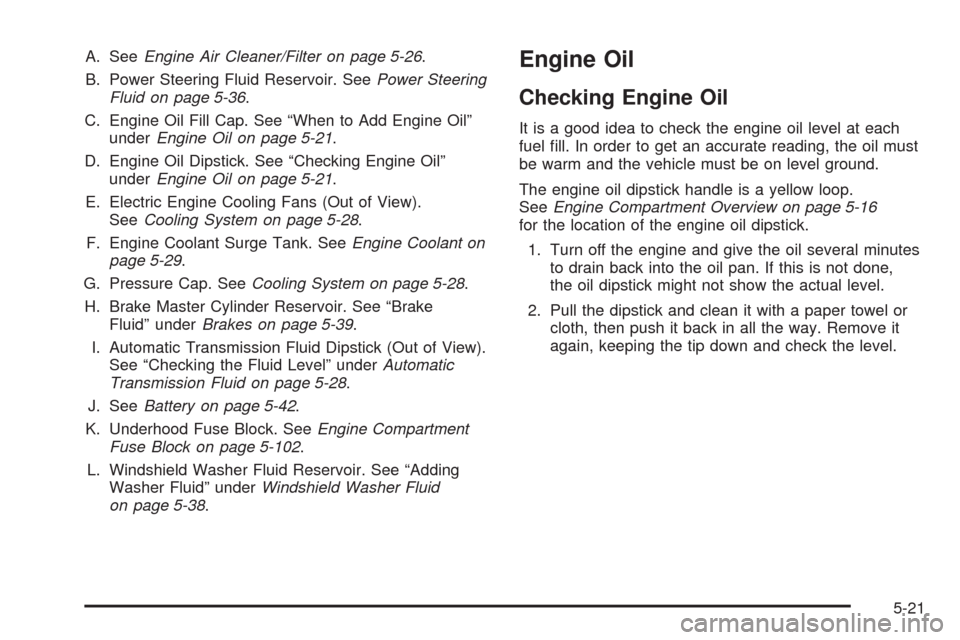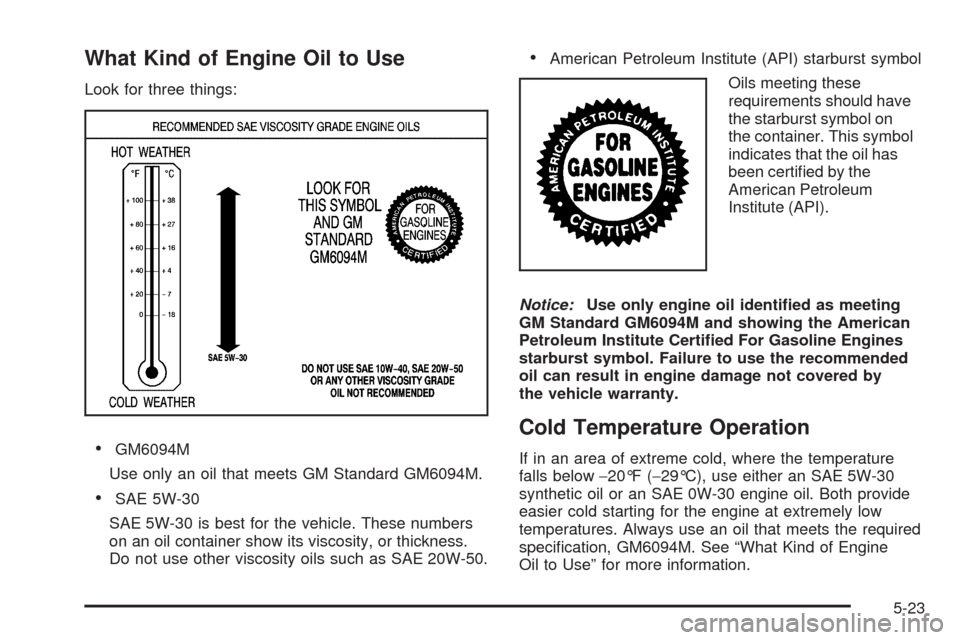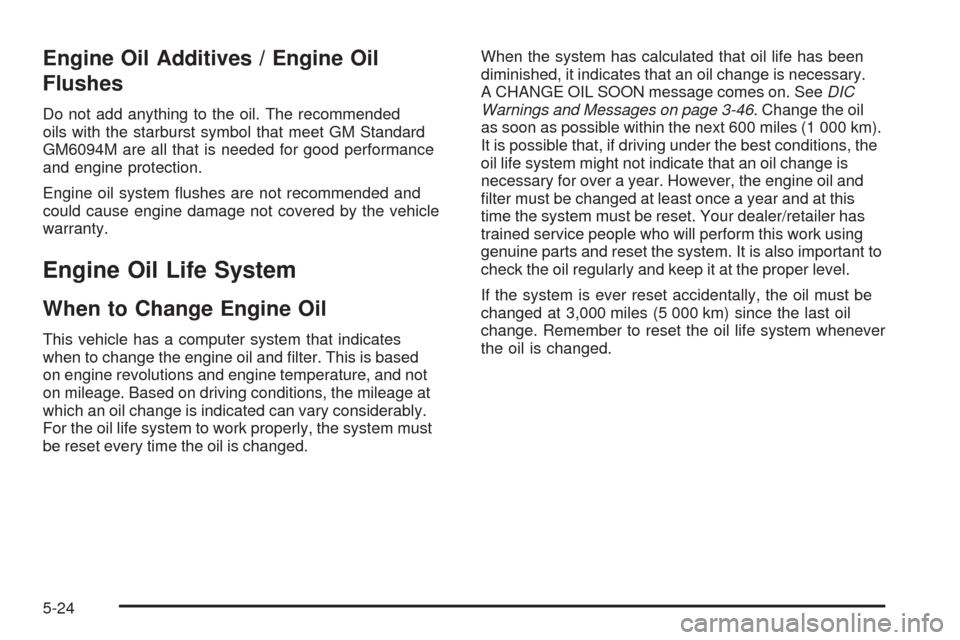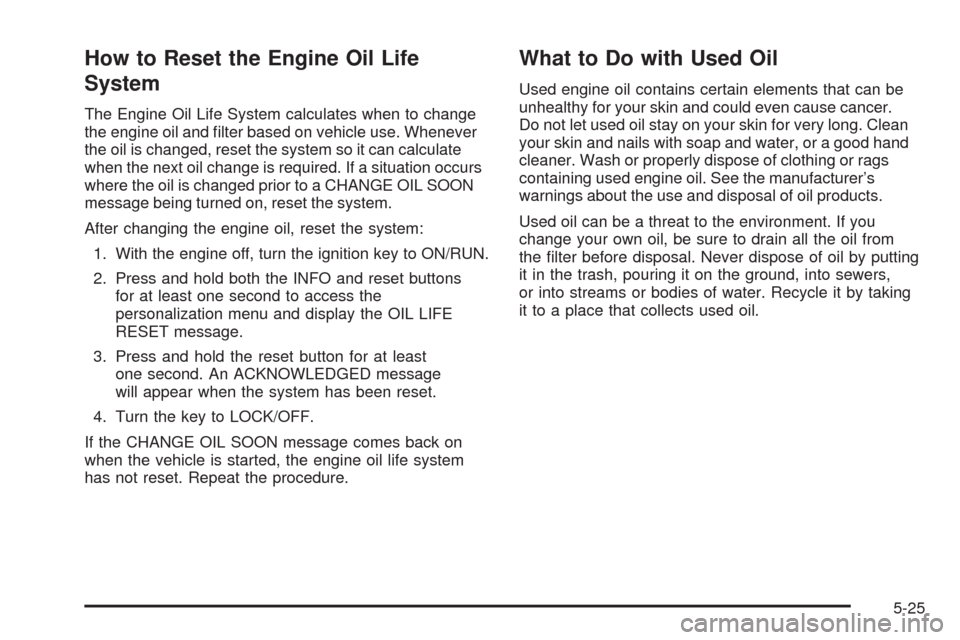Page 277 of 420
A. SeeEngine Air Cleaner/Filter on page 5-26.
B. Power Steering Fluid Reservoir. SeePower Steering
Fluid on page 5-36.
C. Engine Cooling Fan. SeeCooling System on
page 5-28.
D. Engine Oil Fill Cap. See “When to Add Engine Oil”
underEngine Oil on page 5-21.
E. Engine Oil Dipstick. See “Checking Engine Oil”
underEngine Oil on page 5-21.
F. Engine Coolant Surge Tank. SeeEngine Coolant on
page 5-29.G. Pressure Cap. SeeCooling System on page 5-28.
H. Brake Master Cylinder Reservoir. See “Brake
Fluid” underBrakes on page 5-39.
I. Automatic Transmission Fluid Cap/Dipstick (Out of
View). SeeAutomatic Transmission Fluid on
page 5-28.
J. SeeBattery on page 5-42.
K. SeeEngine Compartment Fuse Block on
page 5-102.
L. Windshield Washer Fluid Reservoir. See “Adding
Washer Fluid” underWindshield Washer Fluid
on page 5-38.
5-19
Page 278 of 420
When you open the hood on the 3.6L V6 engine, this is what you see:
5-20
Page 279 of 420

A. SeeEngine Air Cleaner/Filter on page 5-26.
B. Power Steering Fluid Reservoir. SeePower Steering
Fluid on page 5-36.
C. Engine Oil Fill Cap. See “When to Add Engine Oil”
underEngine Oil on page 5-21.
D. Engine Oil Dipstick. See “Checking Engine Oil”
underEngine Oil on page 5-21.
E. Electric Engine Cooling Fans (Out of View).
SeeCooling System on page 5-28.
F. Engine Coolant Surge Tank. SeeEngine Coolant on
page 5-29.
G. Pressure Cap. SeeCooling System on page 5-28.
H. Brake Master Cylinder Reservoir. See “Brake
Fluid” underBrakes on page 5-39.
I. Automatic Transmission Fluid Dipstick (Out of View).
See “Checking the Fluid Level” underAutomatic
Transmission Fluid on page 5-28.
J. SeeBattery on page 5-42.
K. Underhood Fuse Block. SeeEngine Compartment
Fuse Block on page 5-102.
L. Windshield Washer Fluid Reservoir. See “Adding
Washer Fluid” underWindshield Washer Fluid
on page 5-38.Engine Oil
Checking Engine Oil
It is a good idea to check the engine oil level at each
fuel �ll. In order to get an accurate reading, the oil must
be warm and the vehicle must be on level ground.
The engine oil dipstick handle is a yellow loop.
SeeEngine Compartment Overview on page 5-16
for the location of the engine oil dipstick.
1. Turn off the engine and give the oil several minutes
to drain back into the oil pan. If this is not done,
the oil dipstick might not show the actual level.
2. Pull the dipstick and clean it with a paper towel or
cloth, then push it back in all the way. Remove it
again, keeping the tip down and check the level.
5-21
Page 280 of 420
When to Add Engine Oil
If the oil is below the MIN mark for the L4 engine or
below the cross-hatched area at the tip of the dipstick
for the V6 engine, add at least one quart/liter of the
recommended oil. This section explains what kind of oil
to use. For engine oil crankcase capacity, seeCapacities
and Specifications on page 5-108.Notice:Do not add too much oil. If the engine
has so much oil that the oil level gets above the
upper mark that shows the proper operating range,
the engine could be damaged.
SeeEngine Compartment
Overview on page 5-16
for the location of the
engine oil �ll cap.
Add enough oil to put the level somewhere in the proper
operating range. Push the dipstick all the way back in
when through. L4 Engine
V6 Engine
5-22
Page 281 of 420

What Kind of Engine Oil to Use
Look for three things:
GM6094M
Use only an oil that meets GM Standard GM6094M.
SAE 5W-30
SAE 5W-30 is best for the vehicle. These numbers
on an oil container show its viscosity, or thickness.
Do not use other viscosity oils such as SAE 20W-50.
American Petroleum Institute (API) starburst symbol
Oils meeting these
requirements should have
the starburst symbol on
the container. This symbol
indicates that the oil has
been certi�ed by the
American Petroleum
Institute (API).
Notice:Use only engine oil identi�ed as meeting
GM Standard GM6094M and showing the American
Petroleum Institute Certi�ed For Gasoline Engines
starburst symbol. Failure to use the recommended
oil can result in engine damage not covered by
the vehicle warranty.
Cold Temperature Operation
If in an area of extreme cold, where the temperature
falls below−20°F (−29°C), use either an SAE 5W-30
synthetic oil or an SAE 0W-30 engine oil. Both provide
easier cold starting for the engine at extremely low
temperatures. Always use an oil that meets the required
speci�cation, GM6094M. See “What Kind of Engine
Oil to Use” for more information.
5-23
Page 282 of 420

Engine Oil Additives / Engine Oil
Flushes
Do not add anything to the oil. The recommended
oils with the starburst symbol that meet GM Standard
GM6094M are all that is needed for good performance
and engine protection.
Engine oil system �ushes are not recommended and
could cause engine damage not covered by the vehicle
warranty.
Engine Oil Life System
When to Change Engine Oil
This vehicle has a computer system that indicates
when to change the engine oil and �lter. This is based
on engine revolutions and engine temperature, and not
on mileage. Based on driving conditions, the mileage at
which an oil change is indicated can vary considerably.
For the oil life system to work properly, the system must
be reset every time the oil is changed.When the system has calculated that oil life has been
diminished, it indicates that an oil change is necessary.
A CHANGE OIL SOON message comes on. SeeDIC
Warnings and Messages on page 3-46. Change the oil
as soon as possible within the next 600 miles (1 000 km).
It is possible that, if driving under the best conditions, the
oil life system might not indicate that an oil change is
necessary for over a year. However, the engine oil and
�lter must be changed at least once a year and at this
time the system must be reset. Your dealer/retailer has
trained service people who will perform this work using
genuine parts and reset the system. It is also important to
check the oil regularly and keep it at the proper level.
If the system is ever reset accidentally, the oil must be
changed at 3,000 miles (5 000 km) since the last oil
change. Remember to reset the oil life system whenever
the oil is changed.
5-24
Page 283 of 420

How to Reset the Engine Oil Life
System
The Engine Oil Life System calculates when to change
the engine oil and �lter based on vehicle use. Whenever
the oil is changed, reset the system so it can calculate
when the next oil change is required. If a situation occurs
where the oil is changed prior to a CHANGE OIL SOON
message being turned on, reset the system.
After changing the engine oil, reset the system:
1. With the engine off, turn the ignition key to ON/RUN.
2. Press and hold both the INFO and reset buttons
for at least one second to access the
personalization menu and display the OIL LIFE
RESET message.
3. Press and hold the reset button for at least
one second. An ACKNOWLEDGED message
will appear when the system has been reset.
4. Turn the key to LOCK/OFF.
If the CHANGE OIL SOON message comes back on
when the vehicle is started, the engine oil life system
has not reset. Repeat the procedure.
What to Do with Used Oil
Used engine oil contains certain elements that can be
unhealthy for your skin and could even cause cancer.
Do not let used oil stay on your skin for very long. Clean
your skin and nails with soap and water, or a good hand
cleaner. Wash or properly dispose of clothing or rags
containing used engine oil. See the manufacturer’s
warnings about the use and disposal of oil products.
Used oil can be a threat to the environment. If you
change your own oil, be sure to drain all the oil from
the �lter before disposal. Never dispose of oil by putting
it in the trash, pouring it on the ground, into sewers,
or into streams or bodies of water. Recycle it by taking
it to a place that collects used oil.
5-25
Page 284 of 420
Engine Air Cleaner/Filter
SeeEngine Compartment Overview on page 5-16for
the location of the engine air cleaner/�lter.
When to Inspect the Engine Air
Cleaner/Filter
Inspect the air cleaner/�lter at the MaintenanceII
intervals and replace it at the �rst oil change after each
50,000 mile (80 000 km) interval. SeeScheduled
Maintenance on page 6-4for more information. If you
are driving in dusty/dirty conditions, inspect the �lter at
each engine oil change.
How to Inspect the Engine Air
Cleaner/Filter
To inspect the air cleaner/�lter, remove the �lter from
the vehicle and lightly shake the �lter to release loose
dust and dirt. If the �lter remains caked with dirt, a new
�lter is required.To inspect or replace the engine air cleaner/�lter, do the
following:
1. Remove the spring clamps that hold the cover on.
2. Lift off the cover.
5-26